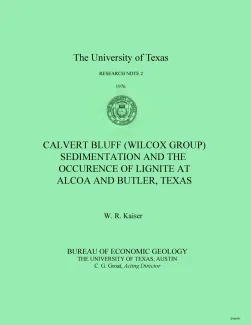Publication Details
Geolocation:
Get the Publication
Abstract/Description:
In east-central Texas, or the area between the Colorado
and Trinity Rivers, the Wilcox Group (lower Eocene) is divided
into three formations. Up section they are the Hooper,
Simsboro, and Calvert Bluff. At Alcoa and Butler, lower Calvert
Bluff sediments are exposed. The Calvert Bluff Formation
conformably overlies the highly resistive, massive, fluvial Simsboro
Sand and is recognized by its finer grain size, as reflected
in reduced resistivity on normal curves, and by the first
occurrence of lignite (fig. 2). The formation is unconformably
overlain by the Carrizo Sand, a high-resistivity unit of fluvial
origin. Lignite is operationally defined to be those beds with
baseline spontaneous potential (SP) and a sharp resistivity spike
(Kaiser, 1974, p. 32). In the Butler-Alcoa area immediately
downdip from the outcrop, the Calvert Bluff is 700 to 1500 ft
thick (213 to 457 m) and averages 1,000 ft thick (305 m,
n=30). Regionally the Calvert Bluff thickens southward, growing
at the expense of the thinning Simsboro. In effect, the lower
Calvert Bluff and upper Simsboro are facies equivalents.
The most important commercial lignite deposits occur in
the lower one-third of the Calvert Bluff immediately above the
Simsboro (fig. 2). Lignite occurs persistently at this stratigraphic
position throughout east-central Texas at the outcrop
and in the subsurface. Commercial deposits occur less persistently
in the upper Calvert Bluff, being best developed north of
the Brazos River. Lignite of lesser importance occurs in the
upper Hooper Formation just below the Simsboro (fig. 2).
Though commercial deposits probably exist, they are expected
to be smaller and more widely scattered along the trend.
